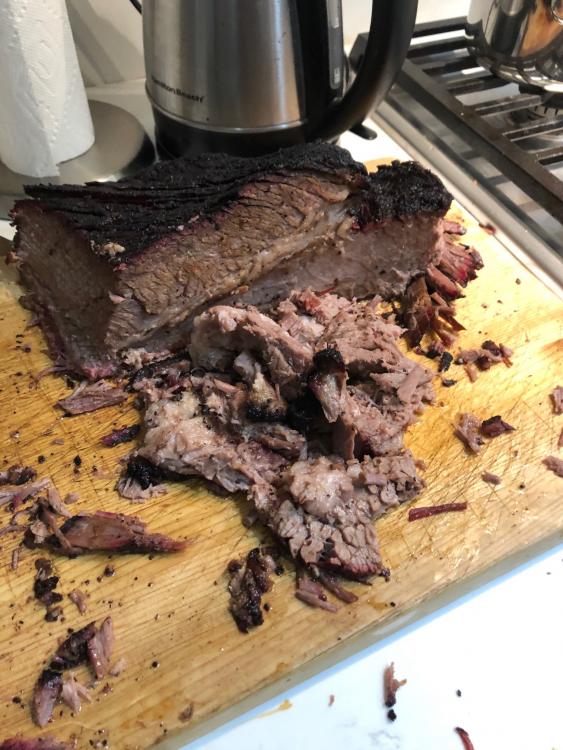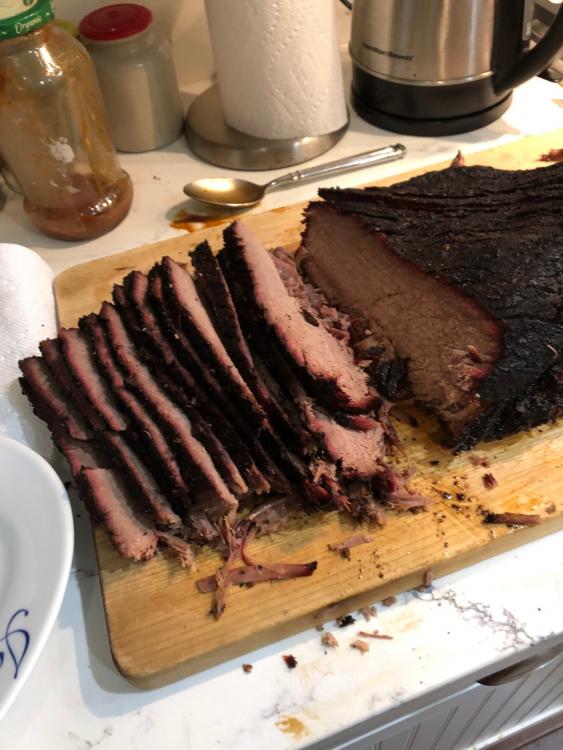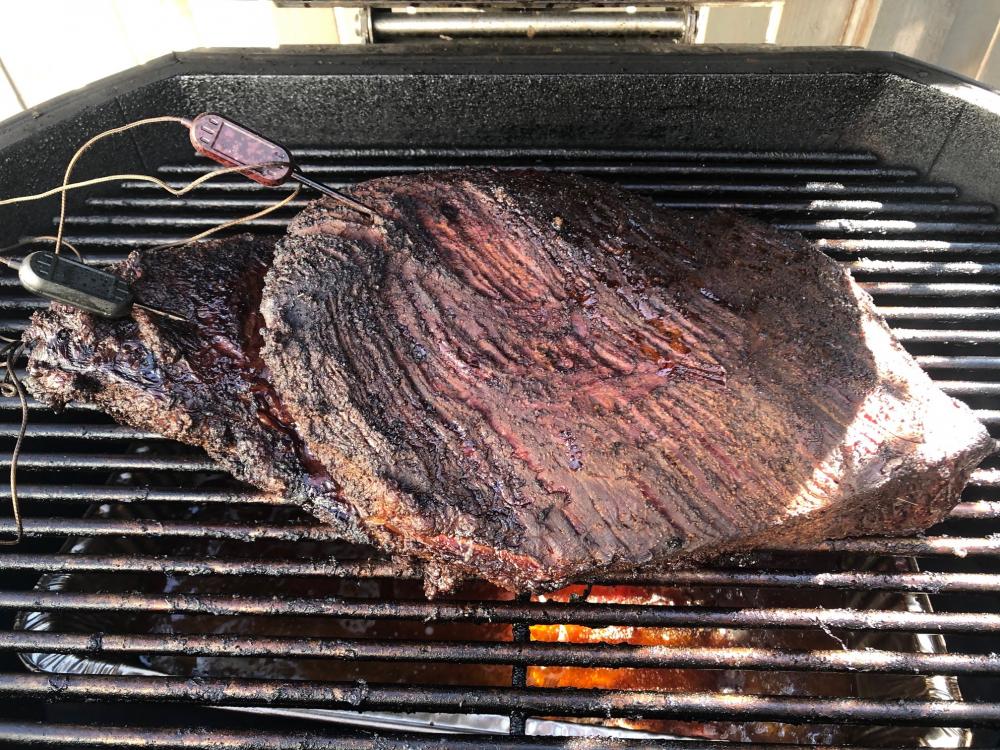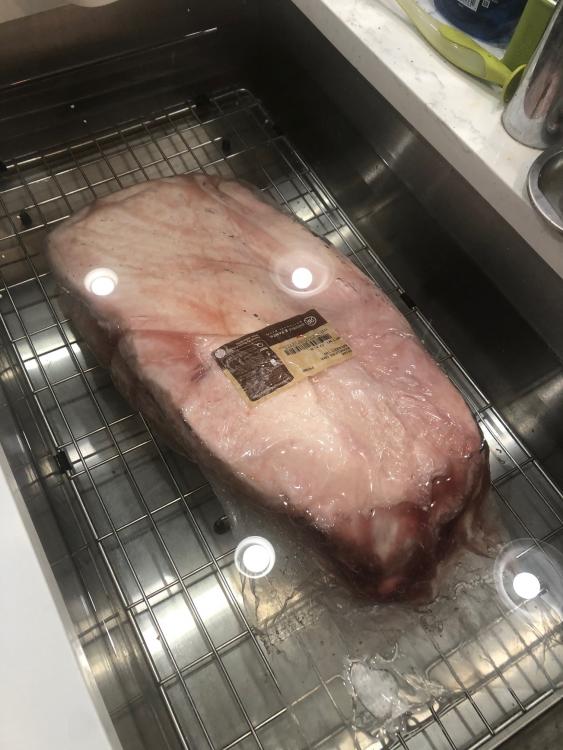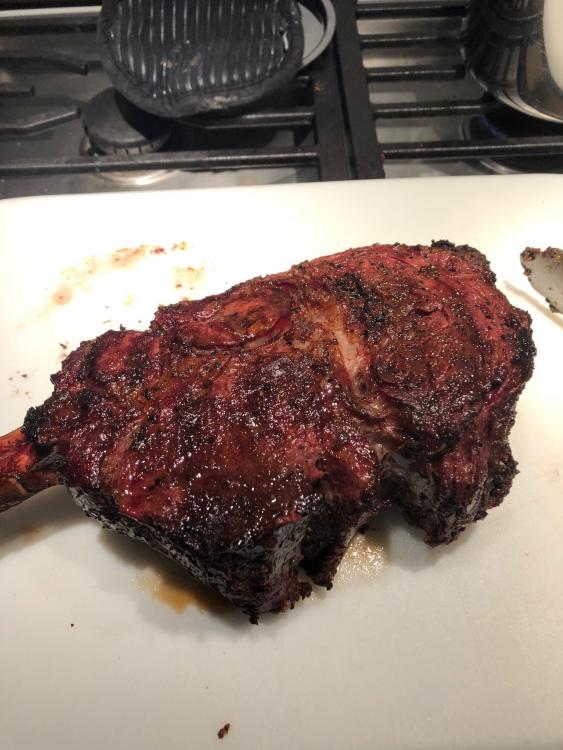-
Posts
343 -
Joined
-
Last visited
-
Days Won
20
Content Type
Profiles
Forums
Events
Everything posted by BARDSLJR
-
Aussie Ora: yes, that makes sense: if you haven't got the walls of the KK fully warmed up, and your temperature reading is reflecting primarily the air temperature, getting the heat level to drop would be less problematic. BTW, binge-watching "Rake", a wonderfully done (albeit it might have gone on a season or two too long) got us through the Coronavirus quarantine period last spring.
-
Gorgeous looking ribs. My experience with my 32" KK is that it is very difficult to get it to reduce temperature once it ramps up. I have had to build up to cooking temp really slowly so not to overshoot it, and then tamp down on the air flow to level it off. I will be using a BBQ Guru for long cooks in the future, so hopefully I will have addressed the control issue. Thank you for clarifying "Ora"- I would have never figured that out. Netflix has made a lot of Australian television accessible, and I can usually figure things out from context: when the guy in "Mr. In-Between"says "we're going out for dimmies", I get he's meaning dim sum dumplings. Some of the language in Peter Temple's excellent mystery books, I just have to guess or Google. (By the way, "Secret City" and "Wanted" were excellent, too. Thank you, my Australian cousins!
-
BTW, there is an added benefit to this approach. Wood, even cured wood, is made up of nearly 50% water, while charcoal has very little moisture. So when you are burning wood, you raise the humidity level in your cooker, which benefits the meat- we are all trying to get our meat cooked to a given temperature to break down the collagens and get it tender, but we want to avoid drying it out- ergo, more wood in the mix is beneficial.
-
Okay, I know we are two nations divided by a common language, but what's "Ora"? I found another reason to cook bone-side down. If you do meat-side down, moisture can collect on the bottom skin-side, possibly causing fractures in the casing that holds the piece together, with potentially disasterous results. I think one of the challenges of cooking KK, or any Kamado-style cooker, is that the airflow is diametrically opposite that of a large offset style smoker. In the case of the offset, one is burning small "logs" of wood for the heat source, and there is very significant air flow up and across the cooking area in order to maintain the cooking heat point. For the KK, one has to tamp down the air flow to a whisper in order to maintain the constant (and low level) heat across the length of the cook, so the volume of smoke that crosses over the meat is dramatically less. AND you don't want a thick smoke, because you don't want a creosote taste imparted to the meat. My solution is - and this is an experiment in progress (I will report on results as I have them) is to adjust the ratio of wood and charcoal in my 32" KK to about 50/50. After I go through the initial ramp up, which generates some pretty thick smoke, I squeeze off the air flow and then have the desired "whisper of light smoke" moving through and maintaining my heat level. I think the next long cook may be beef chuck ribs, which have turned out pretty wonderful in the past. Stay tuned....
-
The original wood supplier I was trying to reconnect with was in Georgia somewhere. With a little more internet sleuthing, I am sure I could find it if it were still open. In the meantime, however, I am very pleased with Fruita, which has for me, being in Denver, the added positive of being closer. They are over in western Colorado, in Grand Junction. I wasn't looking for charcoal, just good quality hardwood. I know have enough apple, oak, cherry, orange, plum, pecan and apricot to last more than a year. Hickory and Mesquite are readily available through local retailers- Home Depot and such.
-
Great advice, just what I was looking for, thanks.
-
Hello all, would love your feedback and recommendations on using a BBQ Guru and which one ...? After this weekend's troubling brisket cook (see separate discussion) I am strongly leaning towards one. I presume the fan motor is fitted to that little aperature on the lower right side of 32" KK? I am leaning toward the Dyna Q with the Pit Viper fan- I don't need any more meat temp probes, have a nice separate unit that bluetooths to my phone for that. So, suggestions and testimonials would be welcome...... Jim in Denver
-
It’s a journey and a challenge, and that’s what makes it fun.
-
As to the first part, having spent what I spent on the KK, I am also certainly subject to the 1-in/out rule from my beloved. (And no more guitars!) I think she was not unhappy that I replaced the Lang, which she said looked like a small locomotive parked at the far end of our courtyard, with the KK, which has a certain aesthetic value. As to the "difference"....Hmmmm. The brisket I have had from some of the better BBQ places in Austin- Franklin's, LA Barbecue, notably- is much better than the best I have produced at home, which was very good. But in addition to using an offset type smoker,they use 500 and 1,000 gallon converted propane tanks for their cooking, so the physics of the air flow and smoke management have to be quite different, and that has to impact the results. I know I can buy the same prime brisket, and we all use pretty much salt and pepper with some small variation. I am also not a professional who cooks (hundreds of pounds) of brisket every night, and learns from that experience. But I have produced excellent brisket on my KK- for sure, yes.
-
Yes, my POS RJ Kamado was made in Sacramento, and the next year they moved production to Mexico. Mine held up for 10-12 years and then began to shed tile and develop cracks. Say more about this Guru?....Where do we order them, how do they work with the KK, etc? I am not familiar.
-
As a point of clarification, I am not saying LANG stick-burners specifically are labor-intensive: ALL stick-burners require pretty frequent restocking of fuel and if so equipped, air flow adjustments. My KK, on the other hand, I can get set and walk away from it for 12 hours and the temp won't budge: on the other hand, you probably have a lot less air movement in the cooking chamber with the KK. So you get something, you give something.
-
Braai-Q- I had a Lang reverse flow stick burner before I switched back over to the KK (had a Richard Johnson Kamado for 12 years before that. Good, but not nearly as well constructed as the KK). The logic of the Lang is that is has a false bottom running the length of the cooking area, and the smoke and heat are supposed to travel the length of bottom, enter the cooking chamber, and exit through the chimney which is on the same end as the firebox. (It looks really strange.) It is supposed to even out the temperature in the cooking area and eliminate hot spots. It does that pretty well. Since I put my water trays on the bottom, underneath the cooking area grill, I don't think there was very much radiant heat from the false bottom area. It made pretty great barbecue. My beef with it (no pun intended) was that it was extremely labor-intensive. One is always adjusting the fuel, the air flow, etc, trying to maintain a constant temp. You can't walk away for 30 minutes. It's about a 15-minute cycle and you are handcuffed to the smoker. A brisket cook would be a marathon. Other than that, build quality was excellent and it worked great.
-
It's a good thing you clarified that about the using the flat only! This wouldn't have made sense at all. I can see where this could be a delicious piece of meat. I always cook a whole packer, do not separate them- that is part of the challenge, to get the flat and the point to finish close to the same time and not under-or-over cook either. In this case, I got the flat to 203 (perfect) and the point 201- close enough. BTW, I took about 12 ounces of the leftover brisket last night, sauteed some bell pepper and onion, added some frozen hash brown potatoes, cooked that to almost done, added the chopped brisket, turning it frequently to get a nice crust worked in, and served it- and it was outstanding.
-
As far as I know, most of the well-known Texas brisket masters, like Aaron Franklin, cook in the 225-250 range until they wrap. Then a lot are upping the temp to 300 to finish. Some, like John Mueller, cook at 300 all the way through. However, almost all of them cook on those large converted propane tank stick burners (with the exception of Snow's, which is an open-pit-over-coals setup), which are very different than cooking on a Kamado style smoker- much more air movement and turbulence, and the heat hits the meat from above...so all in all, very, very different.
-
So Tucker, what is your method? Be interested to hear about different approaches. I know there are a lot of different methods among the more notable Texas pitmasters.
-
Well, here's the results: the good news is, the Snake River brisket is, as advertised, very high quality- though not noticeably better than the prime brisket I can get at Costco for, of course, a lot less per pound. Maybe there could be some debate about this, if you are a real brisket fanatic, maybe you can discern some significant difference: I can't. Second, after all the issues with the early part of the cook, I got it done, and it was....decent. Very good bark (as you can see). I might have even trimmed too much fat- hard to tell. I'm not Aaron Franklin, but I am sure he would know. Good smoke- I like post oak better than anything else I've used (fruitwoods, hickory). The family was happy with and practically inhaled about 2/3rds of the finished brisket, as you see from the middle picture. I also was able to send enough home with them for lunch today for 5. Then, the bad news and the diagnosis: I've had brisket from some of the best- Franklin, LA Barbecue, Snow's, Truth, Mickelthwaite...I know what it CAN be. My flat was tasty but a bit dried out, and therefore not as tender as it could and should be. The point- the fatty part- was more moist and tender but not as good as the best. It may end up as brisket hash tonight, which is not bad. Now, the debrief. Why was it dry? The last one I did came out pretty close to perfect, though not perhaps exactly 'Franklin-level". So remember, the night before I had started the brisket at about 325* and tamped it down to a whisper, thinking it would fall to 275-300. I NEVER thought I'd get up and find the KK nearly cold 5 hours later, at 6 AM. There are several good pitmasters, like John Mueller, who cook at 300*, so I wasn't worried about it starting off hotter than my normal 250*. The meat was still at 135* when I started it back up and brought it up to 275-300 for the rest of the cook. So why did it dry out? We don't know what temp the meat reached at maximum before falling to 135*. So it might have been up as high as 165-70, for all I know, and maybe it dried out in the second phase of cooking. I certainly wouldn't recommend a two-stage cooking method. Also, there is the matter of the "rest". I thought the brisket would finish at 3 or 3:30 and be served at 6- that would have been nearly ideal. It finished faster than I thought- about 1:30-2 and immediately went, wrapped in its butcher paper, into a very tight disposable styrofoam cooler that we had available. Next, dinner got pushed from 6 to 7:30, so the brisket stayed in the hot cooler, "resting" from 2 to 7. It was still 155* when I pulled it out to slice it, just before serving. So maybe I should have rested it less long, and maybe used a cooler which would have allowed for more heat dissipation? It will be different next time, but any brisket cook is a difficult timing challenge. If, for example, you want to start dinner at 6PM, working backwards, you want a 2-3 hour rest, a 12-14 hour cook for a good 15-17 pound brisket. So for a perfect schedule, you'd start the brisket at 2-3 AM or so for a 6PM dinner, and you'd be taking it out to wrap around 6 hours more or less into that. Starting a cook at 2AM really doesn't work for me. If you wrap in foil to keep it moist, you can destroy the bark. So it's a challenge- I will be interested in the thoughts and suggestions from this group, which has many skilled and experienced KK cooks.
-
So...I made a big meat order from Snake River Farms which was delivered yesterday morning, including a 17 1/2 lb prime brisket. So the plan was to first, thaw that huge sucker, which was frozen solid, in the large kitchen sink. That took roughly 6-8 hours and then I trimmed it, slathered with mustard and coated with a sea salt/ medium coarse pepper mixture. The plan at this point was to start the cook at midnight, get up at 6 and check on it, perhaps to wrap at that point, and previous experience indicated it would be done by 1-2 the next afternoon, perfect timing to let it rest for a few hours and serve to my extended family (wife, daughter, son-in-law, 3 grandkids) for dinner. (And probably have enough left for both households for several days.) So I got the KK set up with a nice hardwood lump charcoal and big chunks of post oak. I started the KK at 11 aiming to put the meat on at 12. Here's where we went off the rails, before we started. I used my propane wand to start the fire in one small tennis-ball sized area, as usual. I usually start by giving it a pretty good venting to get the fire going and then choke it off when I am within about 25-50 degrees of where I want to be, because the temperature will continue climb after I tamp it down (a little like steering an ocean liner). So 45 minutes later I came back to check on my cooker and it was already over 300. This is BAD, 'cause experience also tells me it will be quite a while before I can get the temperature to drop to where I had wanted it, around 250*. I choked it down as far as I dared, a whisper of air coming through the bottom vent and and about 1/4 turn off shut at the cap. Checked back 45 minutes later....not much change. URK. At this point it was about 12:45, so I put the brisket on and hoped for the best and went to bed. Did I mention I set up my Aksesroyal bluetooth temperature monitor with one probe in the flat and one in the point? Got up at the unearthly hour of 6, and happily I had put out my LED head lamp (designed for hunters, I think) so I wasn't stumbling around in the dark through the obstacle course Ms. Daneta has created in our sideyeard patio. Did I mention it was pitch black at 6AM? And then the October surprise: my fire has apparently gone out and the 32" KK is...cold. The brisket, however, is not too bad...about 134 from both probes. Okay...I still have 12 hours till dinner, and we are partly there....so I get the propane wand out, restart the fire, this time stand by it until I can level it off at 275, and resume the cook. The photo below is the brisket at 170*, just before I wrapped it with pink butcher paper, tightly, and resumed cooking. This is about 11:30 AM and it was done 203 and 201, respectively, at 1:30. It went straight from the KK into a styrofoam cooler (just barely fit) to rest until we are close to dinner. So wish me luck- I know it's done, and it has some decent bark, and I hope we didn't dry it out and ruin $140 worth of really good beef brisket. More photos and a taste test to follow when I carve this sucker up, in about 2 hours.
-

Another experience with "Cowboy Steak" (bone-in ribeye, thick cut)
BARDSLJR replied to BARDSLJR's topic in KK Cooking
Tyrus, I did a reverse sear, so yes, that is exactly what I did. Whilst I do love me a good Manhattan, they always hurt me the next day... The missus is a Maker's manhattan lady. -

Another experience with "Cowboy Steak" (bone-in ribeye, thick cut)
BARDSLJR replied to BARDSLJR's topic in KK Cooking
Tony, funny you should mention the sous vide option: my wife suggested the same thing. If I were only focusing on cooking to a perfect rare or medium rare, probably that would be the way to go. Finish on the gas grill over the infrared searing burner. But if I were going to start a fire in the KK, I wanted to take advantage of the opportunity to roast it over a natural wood/charcoal fire, and the results, flavor wise, were really, really good. I think maybe some of the variability in the cooking - the temperature fluctuations- might have come from me moving it closer /farther to the radiant heat from the fire. However, I need more experience with this cut of steak to really know what I am doing. -
Two views of last night's "Cowboy Steak", a super thick, 4" ribeye, bone in. The previous attempt, with a 3" cut, was cooked with mesquite wood, and was quite good. Last night I used post oak, and it was also very good, albeit quite different. I did find that cooking the 4" steak was a good deal more difficult, or maybe tricky, than the 3" version. I set up the fire on one side of the KK and roasted it about 18" high over the fire, offset to the "cool" side, at 400-450 degrees, for about 25 minutes, flipping it frequently, then did the sear on the lower grill directly over the remaining fire. It was kind of interesting that in my recollection, the 3" steak cooked at a relatively even rate, and this one was wild: one minute it was testing about 89* in places, and 5 minutes later, up to 135* in spots, a LOT hotter than I wanted. Thankfully, it was big and thick enough that I managed to salvage some very rare slices for my wife, and there were some medium rare pieces perfect for me. I used the usual salt and medium-ground pepper for rub. Both steaks were prime and the flavor was excellent. Next time....I just got 4 3" cowboy steaks delivered from Snake River Farms and I expect the meat quality to be the best.
-
Gorgeous, Tyrus!
-
I'd love to have this T-shirt.
-
I myself prefer medium-rare, a little on the rare side. This is easy when I am cooking two separate steaks (mine goes on first). In this case, where I am cooking one piece of meat, sliced and served for both of us, I fall back on that old Louisiana saying: "If Mama ain't happy, ain't nobody happy."
-
Okay, I was able to Google "Mozzie"....mosquito. But what about "Some German Guy?"
-
So I am a little confused by the "au contraire" comment: are you saying it is too rare or not rare enough? The interior was cooked to just 110*, which is on the rarer side of the rare range.



.thumb.jpg.16980584158a446db7ece9b1b8afb557.jpg)
